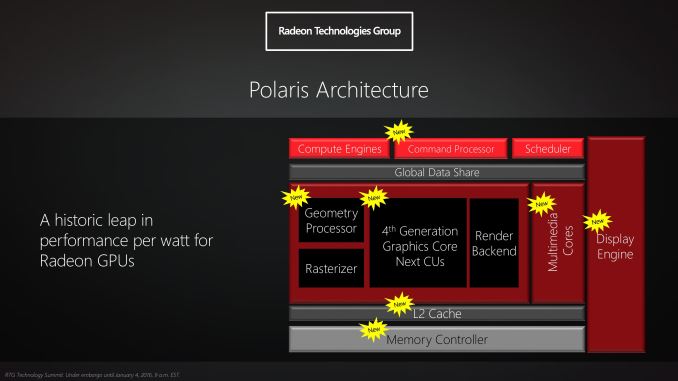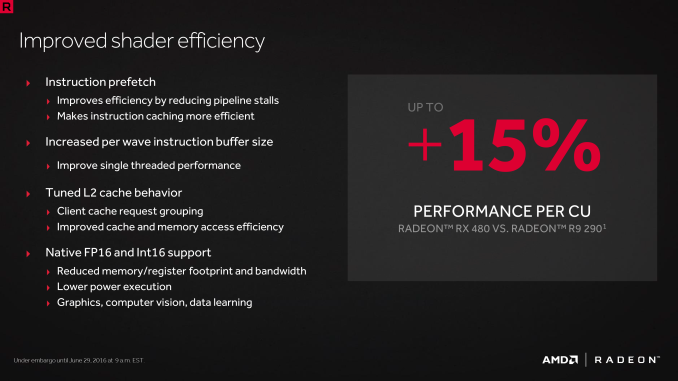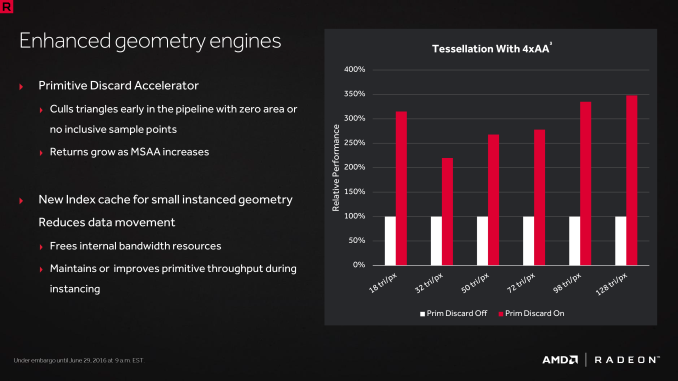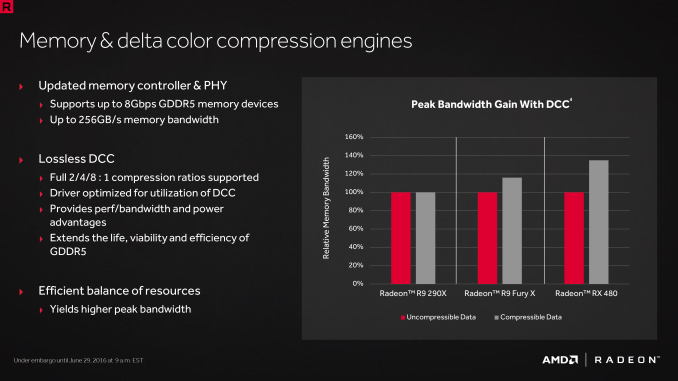The AMD Radeon RX 480 Preview: Polaris Makes Its Mainstream Mark
by Ryan Smith on June 29, 2016 9:00 AM ESTThe Polaris Architecture: In Brief
For today’s preview I’m going to quickly hit the highlights of the Polaris architecture.
In their announcement of the architecture this year, AMD laid out a basic overview of what components of the GPU would see major updates with Polaris. Polaris is not a complete overhaul of past AMD designs, but AMD has combined targeted performance upgrades with a chip-wide energy efficiency upgrade. As a result Polaris is a mix of old and new, and a lot more efficient in the process.
At its heart, Polaris is based on AMD’s 4th generation Graphics Core Next architecture (GCN 4). GCN 4 is not significantly different than GCN 1.2 (Tonga/Fiji), and in fact GCN 4’s ISA is identical to that of GCN 1.2’s. So everything we see here today comes not from broad, architectural changes, but from low-level microarchitectural changes that improve how instructions execute under the hood.
Overall AMD is claiming that GCN 4 (via RX 480) offers a 15% improvement in shader efficiency over GCN 1.1 (R9 290). This comes from two changes; instruction prefetching and a larger instruction buffer. In the case of the former, GCN 4 can, with the driver’s assistance, attempt to pre-fetch future instructions, something GCN 1.x could not do. When done correctly, this reduces/eliminates the need for a wave to stall to wait on an instruction fetch, keeping the CU fed and active more often. Meanwhile the per-wave instruction buffer (which is separate from the register file) has been increased from 12 DWORDs to 16 DWORDs, allowing more instructions to be buffered and, according to AMD, improving single-threaded performance.
Outside of the shader cores themselves, AMD has also made enhancements to the graphics front-end for Polaris. AMD’s latest architecture integrates what AMD calls a Primative Discard Accelerator. True to its name, the job of the discard accelerator is to remove (cull) triangles that are too small to be used, and to do so early enough in the rendering pipeline that the rest of the GPU is spared from having to deal with these unnecessary triangles. Degenerate triangles are culled before they even hit the vertex shader, while small triangles culled a bit later, after the vertex shader but before they hit the rasterizer. There’s no visual quality impact to this (only triangles that can’t be seen/rendered are culled), and as claimed by AMD, the benefits of the discard accelerator increase with MSAA levels, as MSAA otherwise exacerbates the small triangle problem.
Along these lines, Polaris also implements a new index cache, again meant to improve geometry performance. The index cache is designed specifically to accelerate geometry instancing performance, allowing small instanced geometry to stay close by in the cache, avoiding the power and bandwidth costs of shuffling this data around to other caches and VRAM.
Finally, at the back-end of the GPU, the ROP/L2/Memory controller partitions have also received their own updates. Chief among these is that Polaris implements the next generation of AMD’s delta color compression technology, which uses pattern matching to reduce the size and resulting memory bandwidth needs of frame buffers and render targets. As a result of this compression, color compression results in a de facto increase in available memory bandwidth and decrease in power consumption, at least so long as buffer is compressible. With Polaris, AMD supports a larger pattern library to better compress more buffers more often, improving on GCN 1.2 color compression by around 17%.
Otherwise we’ve already covered the increased L2 cache size, which is now at 2MB. Paired with this is AMD’s latest generation memory controller, which can now officially go to 8Gbps, and even a bit more than that when oveclocking.














449 Comments
View All Comments
D. Lister - Thursday, June 30, 2016 - link
@fanofanandWhat he is saying is, that the total power draw of the 2x 1080 from the motherboard is less than 75W, because they take most of the power from the 8-pin connectors, which is true. The same statement is also true for the Radeon 290X, a GPU well-known for massive power use. But even 2x 290/290Xs don't draw so much from the board.
Please refrain from abusive language and think before you post, because it only puts you, your argument and your brand of choice, in a negative light.
fanofanand - Friday, July 1, 2016 - link
You are choosing to scold me for calling him out on his word choices that portray an inaccurate statement? Of all the people on here and all the things they say? Mr. Lister, kindly F off.D. Lister - Saturday, July 2, 2016 - link
:) well, no one who has ever scolded me, used the word "please". Anyhow, you misunderstood the guy, didn't conduct any research in the matter, and instead of replying with an opposing argument/reference you asked for his post to be deleted and then called him an idiot. Acting like that only serves to push you in a weaker position, and drags AT down to the level of places like wccftech. Anyway, I will now kindly F off.Murloc - Tuesday, July 5, 2016 - link
lol what he says puts "his brand of choice" in negative light'guys please get a grip
D. Lister - Tuesday, July 5, 2016 - link
Yeah, complicated, but you'll figure it out once you're done laughing out loud. :)Mode+ - Thursday, June 30, 2016 - link
Standard 12V 6 pin connector is rated up to 192W without the HCS terminals. The specification is for 150W. It's a guideline, not a rule.TheinsanegamerN - Thursday, June 30, 2016 - link
And my car is rated to go up to 120MPH. Doesnt mean that it will work well for long at that speed.Rumpeltroll80 - Monday, July 4, 2016 - link
That is why many are releasing the RX 480 with a 8 pin instead of 6 pin. 150 Watt on a 8 pin, only 75 watt on a 6 pin.So problem seems to be solved then right? Here is one card with the change
http://www.tweaktown.com/news/52878/sapphires-upco...
komplik - Thursday, June 30, 2016 - link
Really? https://www.techpowerup.com/reviews/AMD/RX_480_Cro...In average... slower than single 1070
erple2 - Friday, July 1, 2016 - link
I didn't see that from the charts - I saw it to be faster. Personally, I ignored resolutions below 1440p, as buying 2 of these for those resolutions seems pointless.In the aggregate including games where there was no crossfire scaling, the 1070 was competitive, and slightly faster.